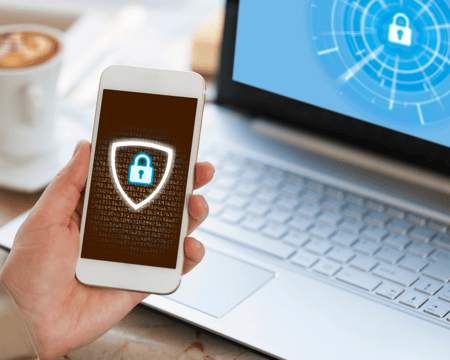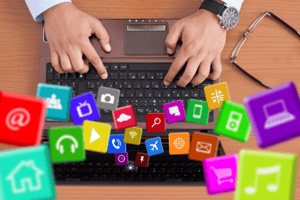Here are some things to think about when deciding to give your child a debit card.
Cybersecurity tips to ensure you and your family’s financial data is secure
Protect your data with these cybersecurity practices.
 Like you use a home security system to protect your home against burglars, keeping your electronic data safe by using cybersecurity measures is important. Your electronic data includes bank account numbers, logins, passwords, and other personal information stored in the cloud or a computer system. This data can be used to steal your identity, money, and even impact your credit. This is why it’s crucial to protect your family’s electronic data.
Like you use a home security system to protect your home against burglars, keeping your electronic data safe by using cybersecurity measures is important. Your electronic data includes bank account numbers, logins, passwords, and other personal information stored in the cloud or a computer system. This data can be used to steal your identity, money, and even impact your credit. This is why it’s crucial to protect your family’s electronic data.
Understanding the types of cyberthreats
While there are many different cyber threats, they can essentially be broken down into three main categories. It’s important to understand what cyber threats look like so you can be aware if you stumble across one of them.
Malware, short for “malicious software,” is software designed to disrupt the device’s functionality and ability to process information. There are several types of malware that serve a number of purposes, but essentially it gives the hacker control over your device. For example, allowing them to steal your data, use your WiFi or server, destroy your device, etc. Examples of malware include trojans, viruses, and adware.
Phishing is a type of cybercrime where you receive emails, phone calls, or texts from seemingly legitimate sources asking you to click links, fill out information, or download software used to steal your data or infect your device. These cybercriminals are trying to get your information by tricking you into giving it to them. Phishing can come in many forms and sometimes contain threatening messages or situations. That’s why it’s important to recognize these types of communications. Examples of phishing include:
- An email claiming you won a brand new BMW, and to claim it, all you have to do is fill out a form with your full name, address, phone number, and company email. Any offer you receive that 1) you didn’t enter yourself or 2) seems too good to be true are immediate red flags to be a potential scam.
- A phone call from an unknown number claiming to be a sheriff saying they have your son/daughter in custody and they need you to wire $5,000 to release them. A law enforcement officer or government official will never call you asking you to wire money, ever. Any person asking you to wire money for any reason is a scam.
- A direct message you receive on Instagram from a random account saying they want you to be a brand ambassador for them and to send them your bank account information so they can pay you to post photos of you in their clothes. Ensure that any brand you engage with on social media is verified with the blue checkmark next to their name; this is the most guaranteed way to confirm you’re speaking to a real brand. However, no legitimate brand or company will ever ask for your bank account information through a direct message, especially with no contract in place.
Hacking is compromising digital devices or accounts by allowing malicious individuals or systems access to your information or accounts. While hacking can be done using phishing tactics or malware, hacking essentially breaks into your device or server using your password(s) or creates a code that breaks into your device on the hacker’s behalf. Typically once your account or device has been hacked, the hacker will change your admin settings to lock you out of the said account, giving them total access and control over your account and its information.
An example of hacking would be downloading a fitness app you saw on an ad on a website, but unfortunately for you, the app was infected with malware to gain access to your Apple ID and take control of your iCloud, Apple Wallet, and more. This is why it’s important to only download apps and software from secure, verified locations – such as the Apple App Store or the Google Play Store.
Protecting your devices
The first step in keeping your data secure is keeping your electronic devices up to date on any programs or security features it allows. As cyber threats continue to get more sophisticated, the security measures that our phones and computers have also need to be continually updated. This is why it’s important to always make sure you have the latest updates available on all of your electronic devices. That means computers, phones, tablets, gaming consoles, and even things like Amazon’s “Alexa.” Updates typically can be found in your device’s Settings.
Any device used to store information (contact info, photos, etc.), purchase anything, login to anything, or even browse websites are susceptible to being hacked. And the first step in combating hackers is keeping your devices up to date.
It’s also important to regularly back up your device’s data. Backing up data means you’re making a copy of your information and keeping it in a second secure location. So in case your primary location (phone, computer, tablet, etc.) gets hacked or infected with malware, you have all of your data saved in a second location. This is helpful in the event of getting hacked, but it also helps in the event something happens to your physical device – like it falls in a pool or gets stepped on and breaks. There are many ways you can backup your data, the most common forms are using a piece of removal media (like a CD or USB drive), storing in an external hard drive, or storing in a cloud backup service.
Encrypting data is another way to ensure your devices are secure. Encryption translates data into a code, so it’s not deciphered without the qualified key. This protects your data if you are hacked. It’s a good practice to keep sensitive data encrypted.
General best cybersecurity practices
Choose secure passwords and change them often. Avoid making passwords to multiple accounts the same and stay away from common password themes that make them easily hackable, like kids’ names, pet names, birthdays, anniversaries, etc.
Using security features like two-factor authentication is also strongly recommended for accounts that contain sensitive data. Two-factor authentication means you need two forms of verification to log in, like using a password and using a unique five-digit code sent to your phone or email at the attempted login. This feature makes hacking your account more difficult and therefore deters certain cyberthreats.
Don’t open/click on links from emails or texts you don’t recognize or did not request to receive. Look out for grammar and spelling mistakes in the emails or any other abnormal features like foreign letters or bizarre send times. If you’re questioning it, don’t open it. Instead, contact the legitimate institution outside of the email if it’s something important to confirm.
Install and utilize antivirus software and firewalls. Many computers have some type of antivirus pre-installed or have a preferred antivirus that works best with their system. Use these forms of protection and keep them updated.
Avoid using public Wi-Fi and when needing to use Wi-Fi outside of the home, investing in a VPN (Virtual Private Network) is an excellent way to ensure your devices use a secure connection.
While no one is immune to cyber threats, using protective measures and backing up your data will help make any issue you may run into less likely and easier to solve if it does happen.
Posted by

Mollie Macklin is a content contributor for The Plinq. Mollie believes knowledge is power and enjoys creating valuable content for young adults navigating big financial decisions to help them create the lifestyle that makes them happy. Mollie also enjoys funny movies, traveling with her boyfriend, playing her Nintendo Switch, and hanging out with her cats in her free time.




